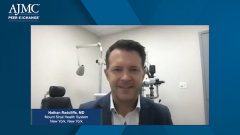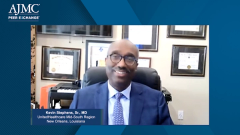
Selective Laser Trabeculoplasty Use in Glaucoma
A review of selective laser trabeculoplasty in glaucoma management, and when it is appropriate to consider as a treatment option.
Episodes in this series

Transcript:
Neil Minkoff, MD: As we move into different types of therapy, laser therapy is another viable treatment option. We try to understand patients on drops vs patients with implants vs patients with laser therapy. Who do you consider appropriate for laser therapy in your practices?
Terri-Diann Pickering, MD: I give patients the option of having laser as initial therapy, I think it’s appropriate, or starting with eye drops, and tell them that the 2 therapies can be used interchangeably during the initial phase of their condition. The key with the laser therapy is to make sure that patients understand that it’s not a cure, and it’s also not cosmetic. They’re not going to be able to see without their glasses or contacts. It also wears off after a while, and it may have to be repeated. They still need to be monitored. The way that I propose laser is that it’s a way of delaying the need to use eye drops. It doesn’t mean that you’ll never have to use eye drops, but it can delay that necessity.
Neil Minkoff, MD: What kind of reduction in pressure do you see after the laser therapy?
Terri-Diann Pickering, MD: It varies dramatically. Just like starting any patient on an eye drop, you don’t know until you try. And I let them know that they may get a partial response from the laser, in which case they’ll still need to use a drop anyway. If we want them to be reduced 25%, and they get a 15% drop, then we must do something else. Then there are also patients who don’t respond at all, where we do the laser and the pressure is completely unchanged. I can’t do the laser for patients who have any sort of angle closure, or narrow-angle glaucoma, or other types of secondary glaucoma.
Neil Minkoff, MD: Dr Radcliffe, anything to add?
Nathan Radcliffe, MD: Yes. There’s now a prospective study that showed, compared to latanoprost, similar efficacy but better visual field preservation and fewer patients getting the laser needing surgery at 3 years. And this was in previously untreated ocular hypertension and early glaucoma. The argument is it’s certainly out there, it’s a reasonable first-line therapy. I do recommend it to patients.
Not everyone will take you up on it because if it’s a new patient, you probably haven’t built any trust with them and you’re suggesting a procedure, despite that it may be better for their eyes, that it may prevent dry eye down the road, that it eliminates compliance problems. Now here we go—despite that it saves their insurance company money, and even going head to head against generic latanoprost, by 12 months, the laser does not pay very much money, relatively speaking. And 2 months of branded therapy is more expensive than 1 laser application. It’s financially better for the physician’s office because we must hire staff to manage our prescription writing, whereas we’re paid a little to perform the laser, and it saves the patient money.
It’s one of the rare situations where the payer, the patient, and the physician are all better off with laser, and yet doctors are still slow to adopt it. But I think that will change. You’ll see some improvements in laser technology over the next few years, and gradually we’ll move toward it as first-line therapy. I believe it should be there, but if they don’t want a laser, they want to do drops, they’re going to make that choice with some frequency.
Neil Minkoff, MD: One of the things that we have trouble with as payers is integration of pharmacy or medical benefit and procedures, trying to figure out where the patient is in their treatment paradigm, and what they’ve done to qualify for laser surgery instead of eye drops, and whether they’ve been forced to fail a drop or something like that. I’d like to hear our payers weigh in on how that integration can occur, and if they’re looking at laser as first-line therapy.
Kevin Stephens, Sr., MD: Typically, we try the most conservative route. We would go with a failure of the medical eye drop opposed to first-line laser. Albeit, if a patient has allergies and so forth, even patient preference, particularly in the commercial plan. In a commercial plan, the formulary, everything is a totally different world than Medicare and Medicaid. In the commercial plan, we have leeway to make benefit exceptions, and I would suggest that the ophthalmologist, when we have those kind of unique situations, you let us know.
One reason is that in the commercial plan, if customer service and satisfaction is not there, then they will bellyache to the employer, and then they will move from one plan to the next. We have a vested interest in keeping our customers happy, and keeping the employees happy is good for the employer, and then we can renew that plan. That different than in the case of Medicare, in which you don’t have that dynamic that you can facilitate some alteration in the standards that are typically used for protocols.
Maria Lopes, MD, MS: The procedures we worry about are high cost and ones that are often misused or used for cosmetic use, and that’s not the case here. Also understanding reimbursement, what Dr Radcliffe said, which is comparative data around the efficacy, that it’s an office-based procedure. In my experience, there’s not even a prior authorization in place for laser procedures. We may pick up abnormalities as we look at practice patterns, looking at if there are aberrancies. There are different ophthalmologists, but otherwise this is not at all something we’re focused on. The only thing we typically need a prior authorization for in terms of procedures would be an iStent, or something that’s done in combination with a cataract procedure.
Transcript edited for clarity.
Newsletter
Stay ahead of policy, cost, and value—subscribe to AJMC for expert insights at the intersection of clinical care and health economics.












































